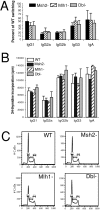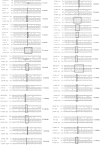Mlh1 can function in antibody class switch recombination independently of Msh2
- PMID: 12743174
- PMCID: PMC2193780
- DOI: 10.1084/jem.20022190
Mlh1 can function in antibody class switch recombination independently of Msh2
Abstract
Mismatch repair proteins participate in antibody class switch recombination, although their roles are unknown. Previous nucleotide sequence analyses of switch recombination junctions indicated that the roles of Msh2 and the MutL homologues, Mlh1 and Pms2, differ. We now asked if Msh2 and Mlh1 function in the same pathway during switch recombination. Splenic B cells from mice deficient in both these proteins were induced to undergo switching in culture. The frequency of switching is reduced, similarly to that of B cells singly deficient in Msh2 or Mlh1. However, the nucleotide sequences of the Smu-Sgamma3 junctions resemble junctions from Mlh1- but not from Msh2-deficient cells, suggesting Mlh1 functions either independently of or before Msh2. The substitution mutations within S regions that are known to accompany switch recombination are increased in Msh2- and Mlh1 single-deficient cells and further increased in the double-deficient cells, again suggesting these proteins function independently in class switch recombination. The finding that MMR functions to reduce mutations in switch regions is unexpected since MMR proteins have been shown to contribute to somatic hypermutation of antibody variable region genes.
Figures



Similar articles
-
Role for mismatch repair proteins Msh2, Mlh1, and Pms2 in immunoglobulin class switching shown by sequence analysis of recombination junctions.J Exp Med. 2002 Feb 4;195(3):367-73. doi: 10.1084/jem.20011877. J Exp Med. 2002. PMID: 11828012 Free PMC article.
-
Molecular characterization of the spectrum of genomic deletions in the mismatch repair genes MSH2, MLH1, MSH6, and PMS2 responsible for hereditary nonpolyposis colorectal cancer (HNPCC).Genes Chromosomes Cancer. 2005 Oct;44(2):123-38. doi: 10.1002/gcc.20219. Genes Chromosomes Cancer. 2005. PMID: 15942939
-
Reduced isotype switching in splenic B cells from mice deficient in mismatch repair enzymes.J Exp Med. 1999 Aug 2;190(3):323-30. doi: 10.1084/jem.190.3.323. J Exp Med. 1999. PMID: 10430621 Free PMC article.
-
[Homologs of MutS and MutL during mammalian meiosis].Med Sci (Paris). 2003 Jan;19(1):85-91. doi: 10.1051/medsci/200319185. Med Sci (Paris). 2003. PMID: 12836196 Review. French.
-
Signalling cell cycle arrest and cell death through the MMR System.Carcinogenesis. 2006 Apr;27(4):682-92. doi: 10.1093/carcin/bgi298. Epub 2005 Dec 6. Carcinogenesis. 2006. PMID: 16332722 Review.
Cited by
-
Repair of programmed DNA lesions in antibody class switch recombination: common and unique features.Genome Instab Dis. 2021;2(2):115-125. doi: 10.1007/s42764-021-00035-0. Epub 2021 Mar 26. Genome Instab Dis. 2021. PMID: 33817557 Free PMC article. Review.
-
Mismatch repair proteins MSH2, MLH1, and EXO1 are important for class-switch recombination events occurring in B cells that lack nonhomologous end joining.J Immunol. 2011 Feb 15;186(4):2336-43. doi: 10.4049/jimmunol.1003104. Epub 2011 Jan 17. J Immunol. 2011. PMID: 21242524 Free PMC article.
-
Mutations occur in the Ig Smu region but rarely in Sgamma regions prior to class switch recombination.EMBO J. 2003 Nov 3;22(21):5893-903. doi: 10.1093/emboj/cdg550. EMBO J. 2003. PMID: 14592986 Free PMC article.
-
PMS2 endonuclease activity has distinct biological functions and is essential for genome maintenance.Proc Natl Acad Sci U S A. 2010 Jul 27;107(30):13384-9. doi: 10.1073/pnas.1008589107. Epub 2010 Jul 12. Proc Natl Acad Sci U S A. 2010. PMID: 20624957 Free PMC article.
-
Deletion of the nucleotide excision repair gene Ercc1 reduces immunoglobulin class switching and alters mutations near switch recombination junctions.J Exp Med. 2004 Aug 2;200(3):321-30. doi: 10.1084/jem.20040052. Epub 2004 Jul 26. J Exp Med. 2004. PMID: 15280420 Free PMC article.
References
-
- Stavnezer, J. 1996. Antibody Class Switching. Academic Press, San Diego. 79–146 - PubMed
-
- Muramatsu, M., K. Kinoshita, S. Fagarasan, S. Yamada, Y. Shinkai, and T. Honjo. 2000. Class switch recombination and hypermutation require activation-induced cytidine deaminase (AID), a potential RNA editing enzyme. Cell. 102:553–563. - PubMed
-
- Revy, P., T. Muto, Y. Levy, F. Geissmann, A. Plebani, O. Sanal, N. Catalan, M. Forveille, R. Dufourcq-Labelouse, A. Gennery, et al. 2000. Activation-induced cytidine deaminase (AID) deficiency causes the autosomal recessive form of the Hyper-IgM syndrome (HIGM2). Cell. 102:565–575. - PubMed
-
- Petersen-Mahrt, S.K., R.S. Harris, and M.S. Neuberger. 2002. AID mutates E. coli suggesting a DNA deamination mechanism for antibody diversification. Nature. 418:99–104. - PubMed
-
- Rada, C., G.T. Williams, H. Nilsen, D.E. Barnes, T. Lindahl, and M.S. Neuberger. 2002. Immunoglobulin isotype switching is inhibited and somatic hypermutation perturbed in UNG-deficient mice. Curr. Biol. 12:1748–1755. - PubMed
Publication types
MeSH terms
Substances
Grants and funding
LinkOut - more resources
Full Text Sources
Molecular Biology Databases

